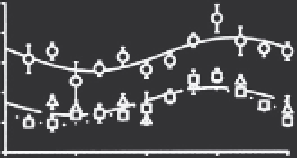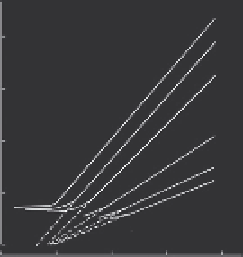Biology Reference
In-Depth Information
intrusions lasting 10-30 s or more. These breathing irregularities are linked
to the occurrence of bursts of rapid eye movements for which REM sleep is
named.
161-163
During sleep, there is a reduction in excitatory cortical input to the upper
is especially problematic during early NREM (stage N1) and REM, sleep
increase in excitatory input to the upper airway muscles and improvement
in airway patency.
169,170
Interestingly, there has been some controversy over the effects of sleep
deprivation on the HCVR with some studies suggesting that sleep depriva-
tion reduces the HCVR and others showing that it does not. With the aid of
the constant routine protocol, Spengler and Shea most convincingly dem-
onstrated that sleep deprivation has no effect on the HCVR.
88
As discussed, a major purpose of breathing is to maintain CO
2
/pH
homeostasis in order to preserve respiratory drive and ensure adequate oxy-
gen availability to tissues. This is certainly true during sleep. During sleep,
sensitivity of the CO
2
regulating mechanism is reduced. As such, much
higher concentrations of CO
2
are required to induce a small increase in ven-
ing brief arousals from sleep, there is an increase in ventilation that serves to
hypercapnia, there is also a state-dependent variation in the ventilatory
A
B
Alert
Quiet
Waking
20
450
400
350
300
250
200
Stage 1
15
WAKE
Stage 2
NREM
REM
10
Stage 3
Stage 4
5
0
6
12
18
24
Zeitgeber time (h)
0
30
35
40
P
A
CO
2
(mm Hg)
45
50
Figure 8.4 Vigilance-state dependence of breathing. (A) Average ventilation over 24 h
in Wake, NREM, and REM as indicated in rats housed in a 12:12 light:dark cycle. (B) State-
dependent variation in the sensitivity of the hypercapnic ventilatory response. (A) Red-



Search WWH ::

Custom Search